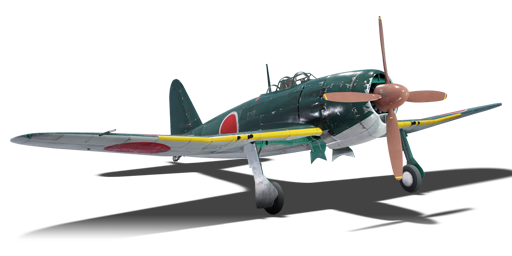




The A7M2, designated as Reppū Mod. 11 (烈風一一型), was a Japanese carrier-based fighter designed by Mitsubishi as the successor to the A6M Zero. It was intended to have superior speed, climb, diving, and armament over the Zero, as well as better manoeuvrability. The development began in 1942 but faced many challenges due to engine selection and wing loading issues. The A7M2 was powered by a 2,200 hp Mitsubishi Ha-43 engine and had a maximum speed of 627 km/h. It was armed with two 20 mm cannons and two 13 mm machine guns, or four 20 mm cannons. Only nine A7M2s were built before the end of the war, and none saw active service.
It was introduced in Update 1.55 "Royal Armour". The A7M Reppū is a superior successor to the A6M Zero. Offering enhanced firepower, with four 20 mm cannons and two 13.2 mm machine guns, compared to the Zero's two 20 mm cannons and two 7.7 mm machine guns. The A7M also has a higher top speed of 628 km/h, thanks to its more powerful engine and improved aerodynamics, while retaining a similar level of agility and manoeuvrability as the Zero. The A7M is suitable for both beginners and experts, as it can outmanoeuvre most enemies in a dogfight, catch up with more foes than the Zero in a chase, and carry plenty of ammunition to sustain prolonged engagements. The A7M also has some versatile rockets that can destroy both air and ground targets; The rockets can be used to surprise enemy bombers or fighters with its distance fuse or to attack ground vehicles or installations with their impressive payload. However, the rockets are heavy and reduce the A7M's performance, so they should be used wisely and sparingly.
flaps
flaps
flaps
brake
| Belt | Belt filling | Armor penetration (mm) at a distance: | |||||
|---|---|---|---|---|---|---|---|
| 10 m | 100 m | 500 m | 1000 m | 1500 m | 2000 m | ||
| T/FI/FI/APHE | 26 | 24 | 17 | 10 | 6 | 4 | |
| HEF-T/HEF/HEF/APHE | 26 | 24 | 17 | 10 | 6 | 4 | |
| APHE/APHE/APHE/APHE/HEF/HEF-T | 26 | 24 | 17 | 10 | 6 | 4 | |
| HEF-T | 4 | 4 | 3 | 3 | 3 | 3 | |
| HEF/HEF/HEF/APHE/APHE | 26 | 24 | 17 | 10 | 6 | 4 | |
| Belt | Belt filling | Armor penetration (mm) at a distance: | |||||
|---|---|---|---|---|---|---|---|
| 10 m | 100 m | 500 m | 1000 m | 1500 m | 2000 m | ||
| T/AP/AP/IAI | 28 | 26 | 19 | 13 | 8 | 6 | |
| AP-I/API-T/IAI/IAI | 27 | 25 | 18 | 11 | 7 | 5 | |
| AP-I/AP-I/API-T/IAI | 27 | 25 | 18 | 11 | 7 | 5 | |
| AP-I/AP-I/IAI | 27 | 25 | 18 | 11 | 7 | 5 | |












Flight performance | |
|---|---|
Survivability |
|---|
Weaponry | ||
|---|---|---|